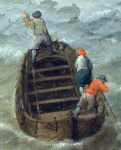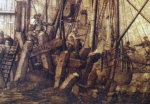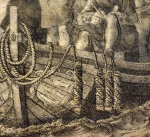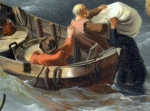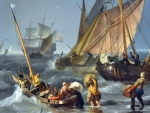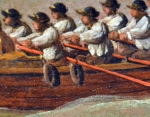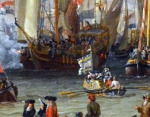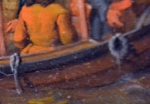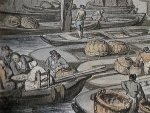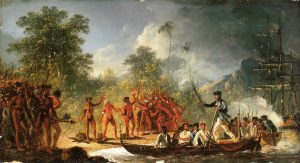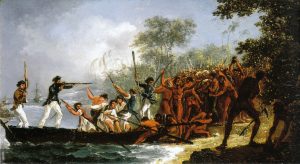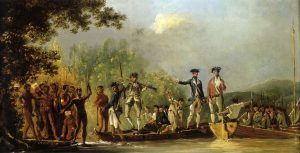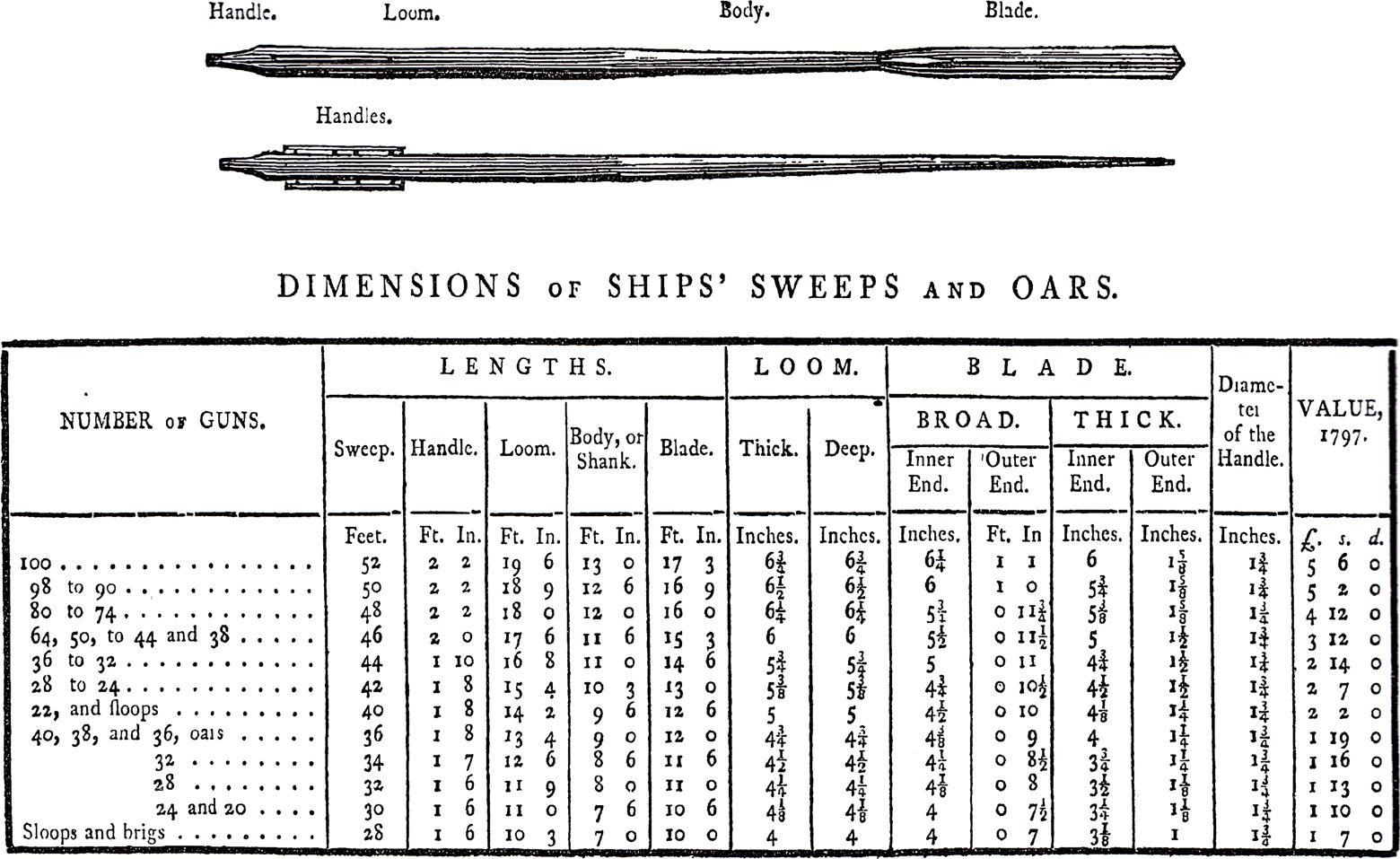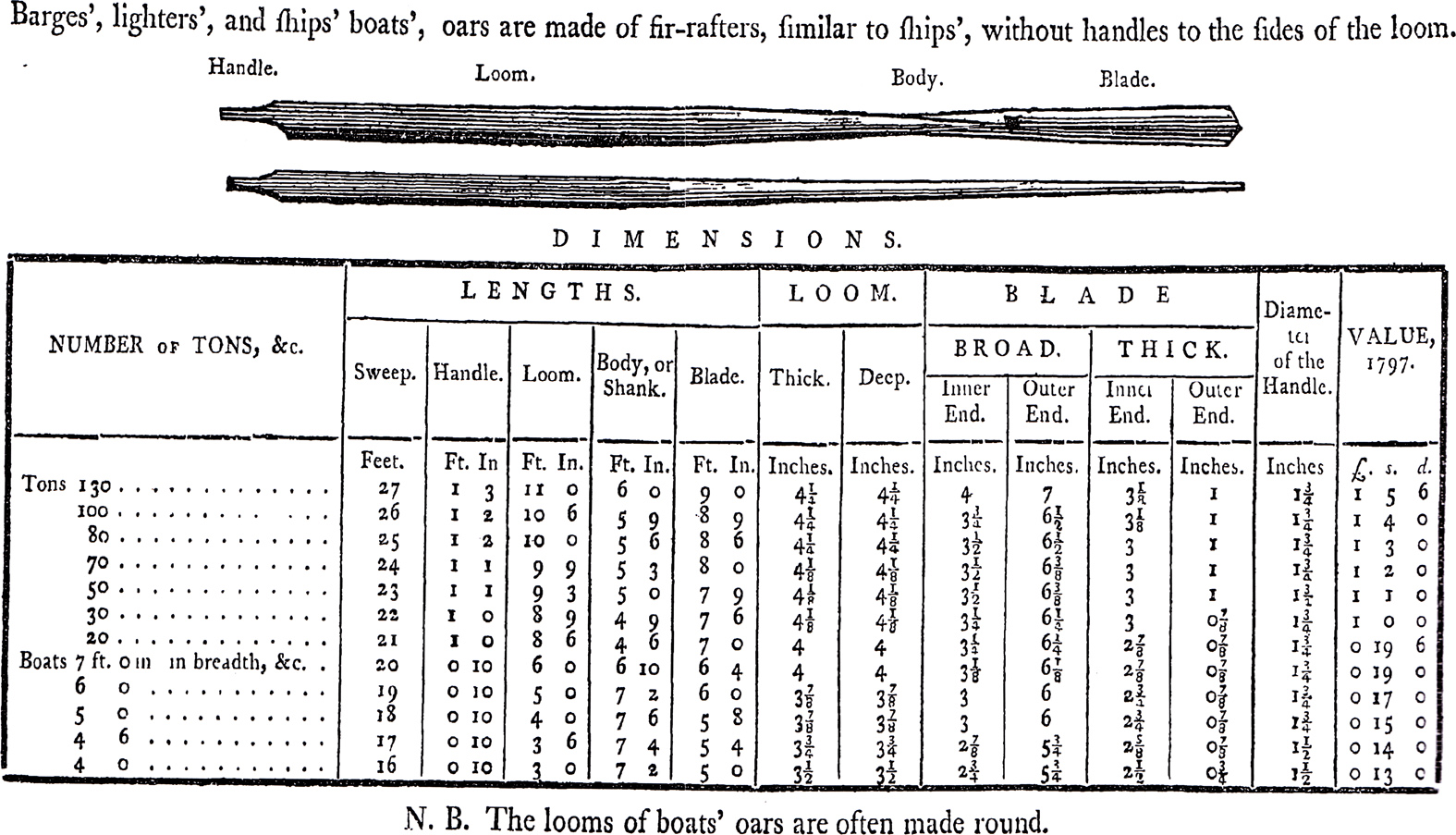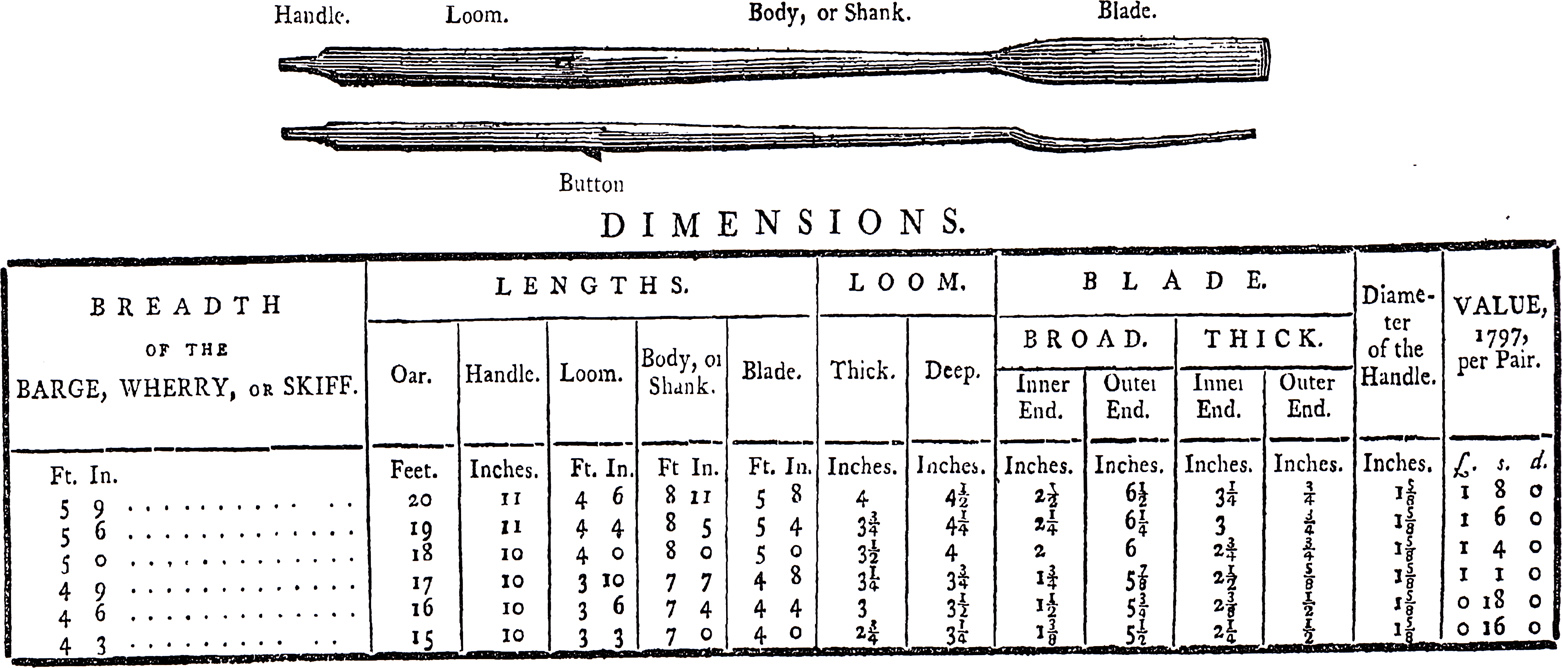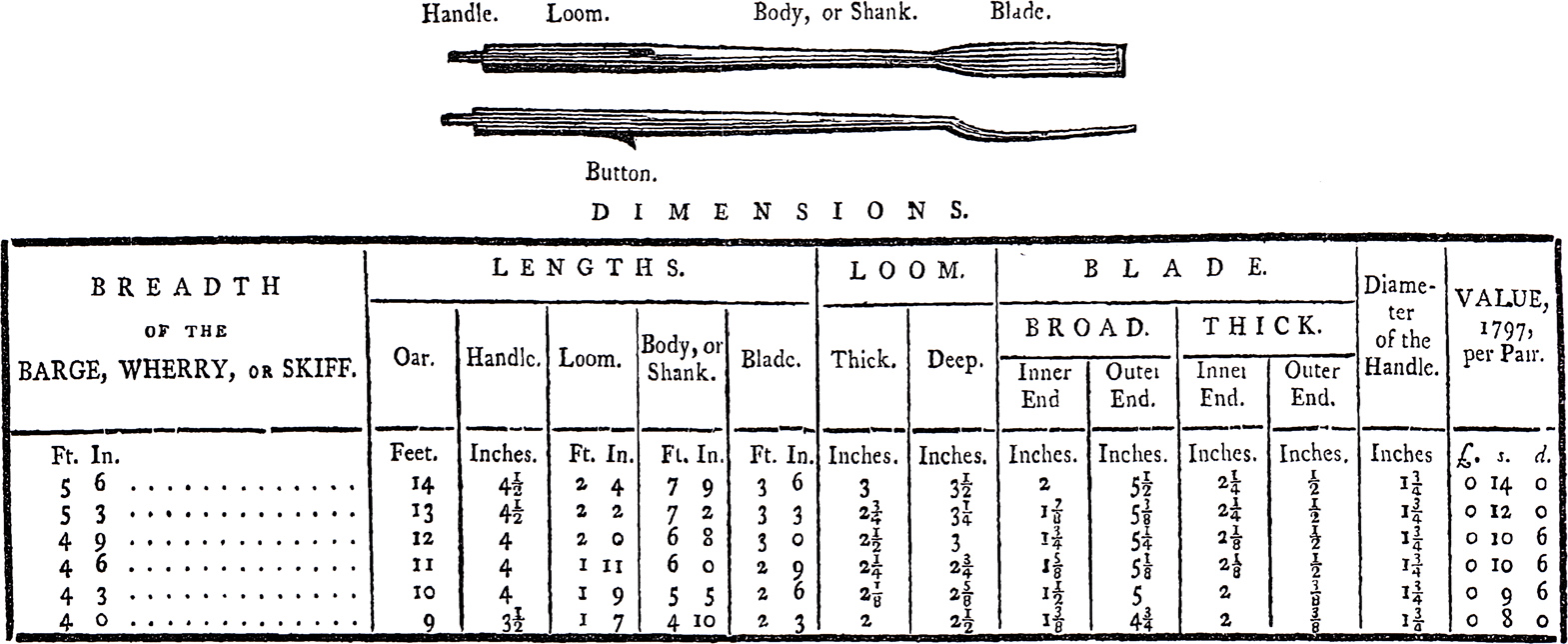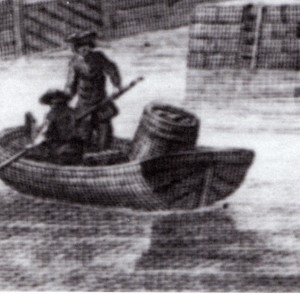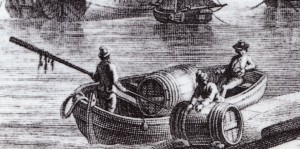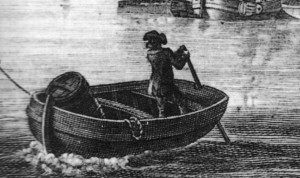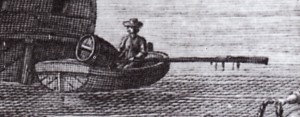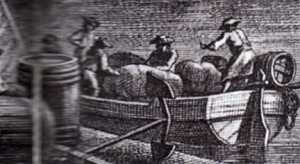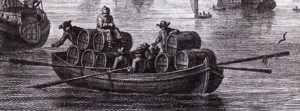Here is a whole collection of period images of fenders:
About David Manthey
Posts by David Manthey
Three paintings of Captain Cook’s crew
Here are three paintings by William Hodges, the expedition painter from Captain Cook’s second Pacific voyage. Each was painted in 1775 or 1776 based on experiences from 1774.
Of interest is that the sailors are generally in shirt sleeves (sometimes rolled up), often without neck cloths. One even appears to be without a shirt (though with a neck cloth). Some do have hats and jackets, but many are bare-headed. The marines, by contrast, and wearing uniforms with coats and hats. Some wear breaches and some wear trousers. The sailors sometimes are holding the muskets for the marines.
Note the sea-going oars (long, thin blades).
Position of thwarts and thole pins
I have a copy of W. E. May’s book Boats of Men of War. It is an excellent book that I recommend. Amongst other items in the book are a fair number of reproductions of draughts of ship’s boats. One showing an 18′ cutter seemed to have a very small height between the top of the thwarts and the bottom of the chocks for the thole pins. Out of curiosity, I measured each of the draughts where I could identify the chock-to-thwart distances reliably. Here is a summary of my results:
| Boat | Year | Length | Beam | No. of thwarts | Double banked? | Thwart spacing | Vertical height between thwart and chock | Horizontal distance from chock center to aft edge of thwart |
| Barge | 1809 | 32′ | 7′ 6″ | 7 | Yes | 3′ 0″ | 9.9″ | 7.5″ |
| Pinnace | 1815 | 37′ 6″ | 8′ | 9 | Yes | 2′ 11.5″ | 10.5″ | 10″ |
| Yawl | 1799 | 26′ | 6′ 6″ | 6 | No | 2′ 7.5″ | 9″ | 10.6″ |
| Cutter | 1764 | 28′ | 6′ 7″ | 8 | No | 2′ 2″ | 8.2″ | 9.8″ |
| Cutter | 1786 | 28′ | 7′ 1″ | 8 | No | 2′ 3″ | 9.1″ | 10.6″ |
| Yawl | 21′ | 6′ 5″ | 6 | No | 2′ 4.5″ | 7.9″ | 11.6″ | |
| Cutter | 1800 | 18′ | 6′ 6.5″ | 4 | No | 2′ 10″ | 6.2″ | 9″ |
| Launch | 1779 | 29′ | 8′ 7″ | 7 | Yes | 2′ 10.8″ | 7.2″ | 9.2″ |
| Launch | 1804 | 33′ | 9′ 10″ | 8 | Yes | 2′ 9.2″ | 8.4″ | 9.7″ |
| Launch | 1815 | 35′ 10.5″ | 9′ 8.5″ | 9 | Yes | 2′ 11.6″ | 10.2″ | 10.5″ |
| Gig | 1815 | 25′ 4″ | 5′ 7″ | 6 | No | 2′ 7.3″ | 6″ | 9.8″ |
Having only 6 inches between the thwart and chock seems too small, even if the rower is sitting on the far side of the boat.
A Boat on a Wagon
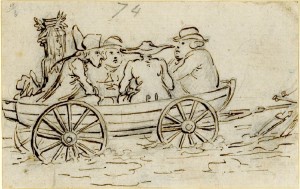 While browsing images in the British Museum, I came across this print. I don’t know how permanent it will be, but here is a link.
While browsing images in the British Museum, I came across this print. I don’t know how permanent it will be, but here is a link.
The caption reads “A party of people in a boat on wheels being pulled to right”. Museum number 1868,0328.173. Drawn by James Gillray, British, 1772-1794.
Oars – David Steel, 1797
I obtained a reprint of The Art of Making Masts, Yard, Gaffs, Boom, Blocks, and Oars by David Steel, from 1797.
This is an Gale ECCO reprint. That is, an original copy in the British National Library was photographed on to microfilm. The microfilm was later digitized. That digital copy has been printed. The print quality of spotty — some things are hard to read, this volume appears to be missing many of the plates related to mask making, and some plates are very eccentrically split between multiple pages. Despite this, it is better than not having a copy.
I reproduce the section on oar making below:
Oar-Making
The different parts of oars are described by the engraved figures, and their dimensions by the tables.
Ships’ sweeps and oars are made of hand-masts, or rafters, suited to the size and length, as per table. They should be chosen straight-grained, free from large knots, shakes, or rind-galls. They are first sawed, or jambed in a snatch-block, and hewed nearly to their size; then raised on horses, and completed by the drawing-knife, spoke-shave, or plane. Open handles are nailed to the sides of the loom in the direction of the flat of the blade, made of oak, about one inch and three-quarters deep, and two inches and one-quarter thick, hollowed to admit the hand easy between that and the loom: the length of the handle is one-third the length of the loom.
Barges’, lighters’ and ships’ boats’, oars are made of fir-rafters, similar to ships’, without handles to the sides of the loom.
N.B. The looms of boats’ oars are often made round.
Oars and sculls for barges, wherries, and skiffs, are made of ash (and sometimes of fir) rafters, which should be chosen tough, straight-grained, without shakes or large knots. The rough wood is taken off with an axe, and finished in a neat manner on horses by drawing-knives, spoke-shaves, and planes. A leather button is nailed on the foreside, about two inches from the loom, and that edge rounded, to work easily in the rowlock: the lower end of the blade is strapped round with tin to prevent its splitting.
Sculls for wherries, skiffs, &c. for choice and make are similar to wherries’ oars.
N.B. Oars or sculls made of fir exceed the dimensions in the above tables one-eighth of an inch. The price of fir oars is seven shillings less than ash oars, and fir sculls three shillings and sixpence less than ash sculls.
On Oars
I recently read Eric McKee’s book “Working Boats of Britain: Their Shape and Purpose”, London: Conway Maritime Press Ltd: 1988 (reprinted from 1983), ISBN 0-85177-277-3. It is a very good book, and I highly recommend it to those who are interested in boats.
Of first note, the book is very much about boats and not ships. Moreover, it is about working vessels, rather than pleasure craft. This gives it a focus that is much more in line with my interests than most books.
There are many superlative details in the book, but of especially interest is the section on rowing geometry and on oars. I highlight only a few of the points from pages 135-139.
- Oar lengths tend to be twice the beam of the boat when used in fresh water sculling, a foot shorter than this when rowing side-by-each, and up to three times the beam when pulling (using a single oar). McKee notes that David Steele says that these lengths are 2 1/2 and 3 1/2 times the beam in the early 19th century.
- Blade area tends from small, short, and wide in protect inland waters to large, long, and narrow in open rough water. There is a chart on page 136 that shows typically blade areas versus length and conditions. A 10′ oar used in river conditions has a blade than averages 3/4 sq.ft in area, whereas in open water the area the average is more like 1 1/4 sq.ft. The area varies 1/4 sq.ft.
- Freshwater blades are roughly 1/5 the total length of the oar. Saltwater blades range from 1/4 to 1/3 of the length, with the longer for rougher conditions.
McKee lists a number of points for the geometry of thwarts, thole pins, and foot placement. When constructing a new pulling boat, it would be good to consult his figures.
I note that his figures are what actual working craft use, not some theoretical model, racing shell, or pleasure skiff.
A Possible Boat Wagon
I recently read Captain Watson’s Travels in America: The Sketchbook and Diary of Joshua Rowley Watson, 1771-1818 by Kathleen A. Foster (Philadelphia: University of Pennsylvania Press, 1997, ISBN 0-8122-3384-0. This is a delightful book the focuses on some sketchbooks of watercolors done by a British naval captain while visiting the United States. Plate 85 in this book shows a watercolor entitled “Looking down the Susquehannah fm Wrightsville ferry 25th April 1817”. On the right side, next to an inn, is a wagon which could be a boat wagon. Then again, it could have some other purpose.
Man of War
Charlie Schroeder joined the Big Row in 2010. He has since written a book about reenacting in general — the Big Row features in Chapter 7, and it also gets plenty of mention after that. I strongly recommend his book, Man of War: My Adventures in the World of Historical Reenactment. It is a travelogue, where the travel is through the world of reenacting (across a vast array of time periods), and combines humor and wit very well.
You can get the book through amazon (see http://www.amazon.com/Man-War-Adventures-Historical-Reenactment/dp/1594630917 ), or through any other book store.
Sailors Hats circa 1812
Even though my focus is on fresh water sailors and much more on the 1750-1780 period, I keep running into questions about 1812 sailors hats. I’ve got a small quantity of images that show them off to different degrees, so here they are:
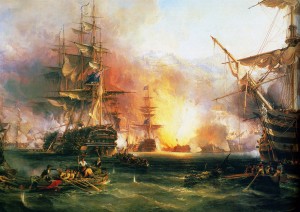 The Bombardment of Algiers, August 27, 1816, by George Chambers, Senior. The sailors in the left foreground seem to have a variety of hats.
The Bombardment of Algiers, August 27, 1816, by George Chambers, Senior. The sailors in the left foreground seem to have a variety of hats.
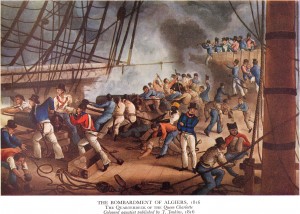 Another painting of Algiers, 1816. This is an aquatint by J. Jenkins entitled “The Quarterdeck of the Queen Charlotte“. Note the brightly colored hat on the dark fellow in the center.
Another painting of Algiers, 1816. This is an aquatint by J. Jenkins entitled “The Quarterdeck of the Queen Charlotte“. Note the brightly colored hat on the dark fellow in the center.
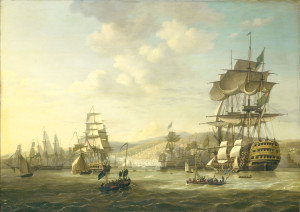 Another of Algiers. This was painted in 1818 by Nicolaas Baur, and is entitled “Anglo-Dutch fleet in the bay of Algiers as support for the ultimatum demanding the release of white slaves on August 26, 1816.” Although the sailors are small in the picture, you can see hat outlines and some colors.
Another of Algiers. This was painted in 1818 by Nicolaas Baur, and is entitled “Anglo-Dutch fleet in the bay of Algiers as support for the ultimatum demanding the release of white slaves on August 26, 1816.” Although the sailors are small in the picture, you can see hat outlines and some colors.
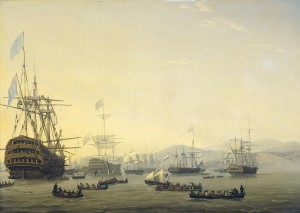 Another paiting by Nicolaas Baur of the Queen Charlotte, 1816.
Another paiting by Nicolaas Baur of the Queen Charlotte, 1816.
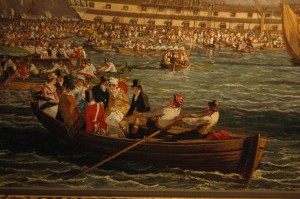 Details of some small boats from a “Scene in Plymouth Sound in August 1815” by John James Chalon. The original painting is at the Queen’s House at the Royal Observatory, Greenwich, England.
Details of some small boats from a “Scene in Plymouth Sound in August 1815” by John James Chalon. The original painting is at the Queen’s House at the Royal Observatory, Greenwich, England.
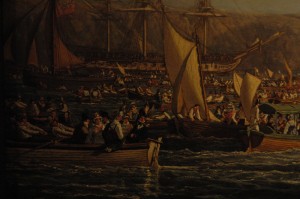 Another detail from a “Scene in Plymouth Sound in August 1815” by John James Chalon.
Another detail from a “Scene in Plymouth Sound in August 1815” by John James Chalon.
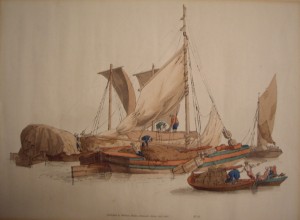 Thames barges, 1805. This is an image from the Maritime Gallery (see http://www.themaritimegallery.co.uk/maritime-archive-1.php).
Thames barges, 1805. This is an image from the Maritime Gallery (see http://www.themaritimegallery.co.uk/maritime-archive-1.php).
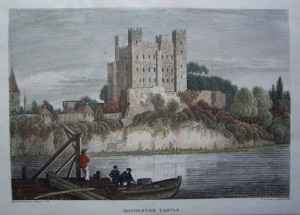 Rochester Castle, circa 1802. Perhaps a bit early for 1812, as far as fashions go. This is an image from the Maritime Gallery (see http://www.themaritimegallery.co.uk/prints-pre-1900-2.php).
Rochester Castle, circa 1802. Perhaps a bit early for 1812, as far as fashions go. This is an image from the Maritime Gallery (see http://www.themaritimegallery.co.uk/prints-pre-1900-2.php).
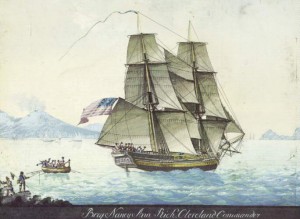 The Brig Nancy Ann, 1809, from the Peabody Essex Museum (see http://www.pem.org/sites/archives/mpd/t0189.htm).
The Brig Nancy Ann, 1809, from the Peabody Essex Museum (see http://www.pem.org/sites/archives/mpd/t0189.htm).
“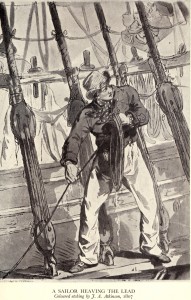 A sailor heaving the lead”, colored etching by J. A. Atkinson, 1807. From A Pageant of the Sea: The MacPherson Collection of Maritime Prints and Drawings, by M. S. Robinson, London: Halton and Company, Ltd., 1950. p. 209.
A sailor heaving the lead”, colored etching by J. A. Atkinson, 1807. From A Pageant of the Sea: The MacPherson Collection of Maritime Prints and Drawings, by M. S. Robinson, London: Halton and Company, Ltd., 1950. p. 209.
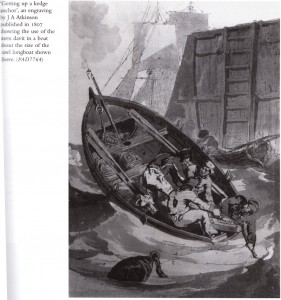 Another drawing by J. A. Atkinson, 1807.
Another drawing by J. A. Atkinson, 1807.
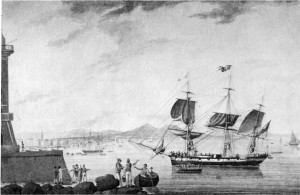 Naples, 1809. From Marine Paintings and Drawings in the Peabody Museum, by M. V. and Dorothy Brewington, p. 178.
Naples, 1809. From Marine Paintings and Drawings in the Peabody Museum, by M. V. and Dorothy Brewington, p. 178.
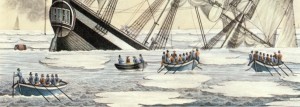 Detail of some boats after a ship at Texel has been cut through by ice, sometime after 1815. Also from Marine Paintings and Drawings in the Peabody Museum, by M. V. and Dorothy Brewington, p. 984.
Detail of some boats after a ship at Texel has been cut through by ice, sometime after 1815. Also from Marine Paintings and Drawings in the Peabody Museum, by M. V. and Dorothy Brewington, p. 984.
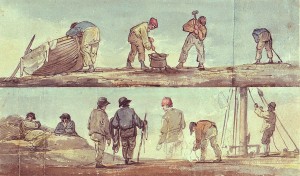 Sailors repairing boats, 1815.
Sailors repairing boats, 1815.



